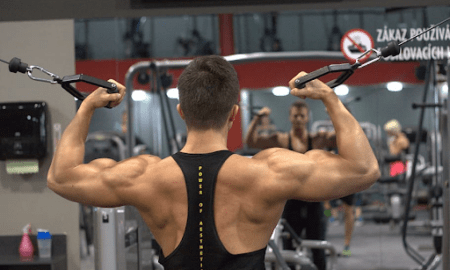 The traditional seated cable row is commonly performed in every heavy gym or gym chain. Virtually all bodybuilders today either include it in their back workouts or have used it in the past. As with many exercises, it has good points and bad points.
The traditional seated cable row is commonly performed in every heavy gym or gym chain. Virtually all bodybuilders today either include it in their back workouts or have used it in the past. As with many exercises, it has good points and bad points.
Its popularity hinges on the dynamic action of the row. You lean forward and stretch your arms forward to full length. Then your lower back initiates the pull by extending the hips and back. At the same time the rowing motion occurs. An enormous amount of muscle is trained at one time: lower lats (latissimus dorsi), upper lats (teres major), middle back (rhomboids, middle and lower trapezius muscles), spinal extensors (muscles along the spine), hamstrings (from leaning forward and leaning back), rear delts (posterior deltoids), biceps and brachioradialis (large forearm muscles). The large amount of muscle activity lends the exercise to a great deal of weight for the strongest trainees. Some powerlifters include it for all those reasons.
It sounds like a good exercise. So what’s the problem with it? The very thing that makes the seated cable row unique is what makes it unusable for some.
Any trainee who begins to do seated cable rows should use light weight, perhaps much lighter than he or she can easily handle. The reason is that the muscles along the spine don’t work the same way as the biceps, pecs and quads do. Research has demonstrated a reason for the lower-back injuries we commonly see in health care. When an average, untrained person rounds his or her back forward, the muscles along the spine decrease in activity to the point that they actually stop firing—it’s known as myoelectric silence. At the point of back rounding, the weight of the upper body and anything you’re holding is taken by the ligaments and disks of your spine. That can lead to a sprain or worse. Those studies were done with untrained individuals and weren’t repeated with trained subjects.
Some trainees experience lower-back pain from seated cable rows, and others never really acclimate to the movement. They start too heavy to begin with and increase the poundage too fast. The solution is to reduce the weight significantly and give the back muscles a chance to actually experience a training effect.
Some trainees have lower-back problems—disk pathology, arthritis, instability—and may not be able to perform seated cable rows because of back pain. They have several options: 1) Drop the cable row; 2) reduce the weight without increasing the reps significantly, as the lower back takes a long time to recover from high-volume training; 3) try to not lean as far forward on the row. You can use your legs or hips to pull the weight back on the first and last rep of each set so you won’t have to lean so far forward.
The problems with the seated cable row led to the creation of seated row machines that have a chest pad to lean against to “protect” the back—the quote marks around protect are not meant to be sarcastic. Some trainees have such serious lower-back problems that an alternative technique is the only way they can row, and any training modification that keeps them in the gym is a good thing. For others, however, the weakness of the lower back creates a vicious circle. Weakness causes many trainees to strain their lower backs so easily that they stop training those muscles. They then become further deconditioned, and new attempts to strengthen them leads to more strain and sprain. In many cases, attempts to protect the back simply reinforce the problem. Some trainees have had so many back strains that they can’t tell the difference between normal training soreness that lasts a few days and injury—but that’s a topic for another time. Train smart, and then train hard.
—Joseph M. Horrigan
Editor’s note: Visit www.SoftTissueCenter.com for reprints of Horrigan’s past Sportsmedicine columns that have appeared in IRON MAN. You can order the books, Strength, Conditioning and Injury Prevention for Hockey by Joseph Horrigan, D.C., and E.J. “Doc” Kreis, D.A., and the 7-Minute Rotator Cuff Solution by Horrigan and Jerry Robinson from Home Gym Warehouse, (800) 447-0008 or at www.Home-Gym.com.




















You must be logged in to post a comment Login